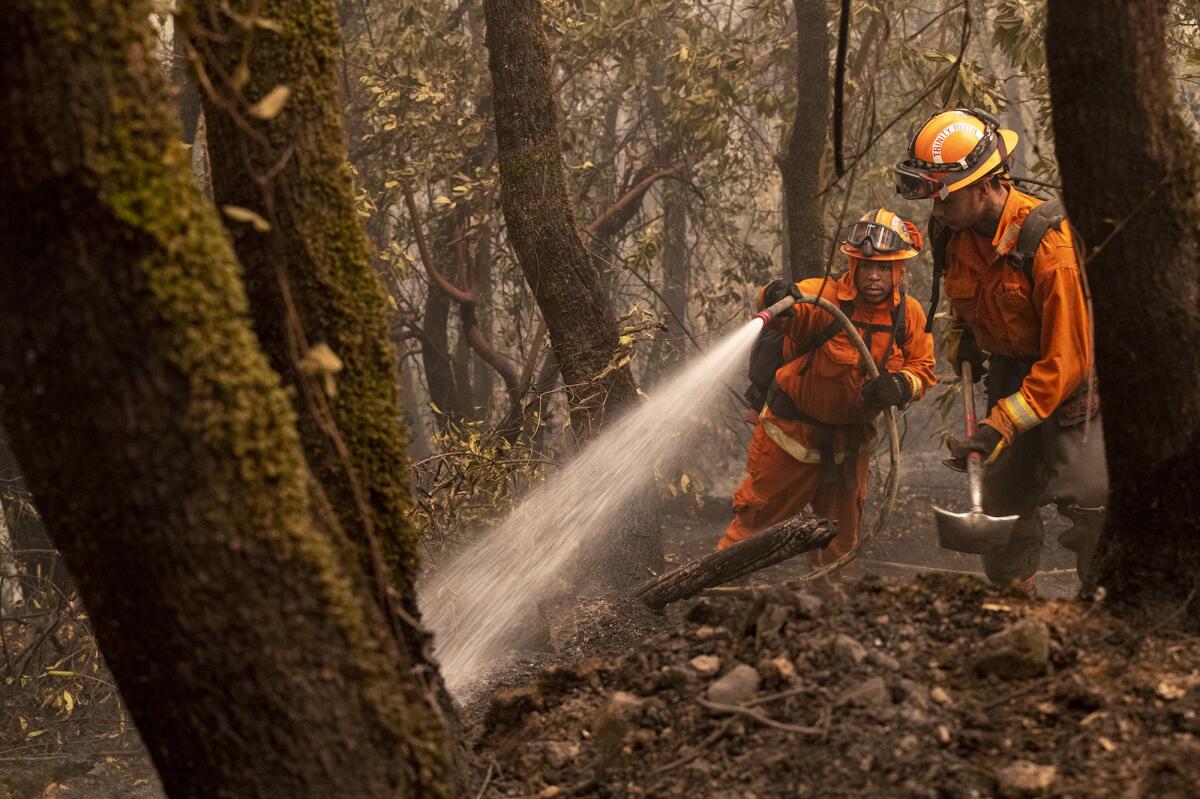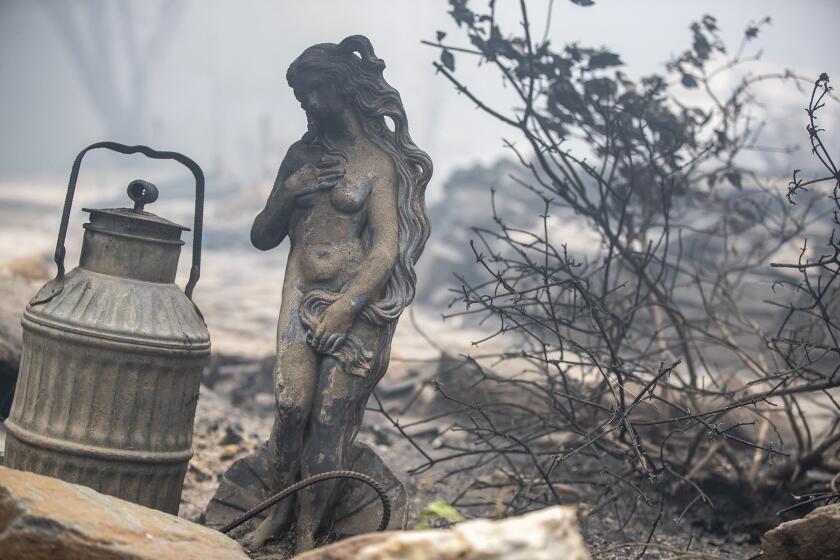Another California firestorm where warnings did not prevent mass deaths

- Share via
BERRY CREEK, Calif. — The turn in the wind was expected.
The U.S. Forest Service and CalFire on Tuesday morning braced for 45-mph gusts across the large Bear fire that had been crawling through the Plumas National Forest — dry and cool air coming from the northeast, so the fire would fan back on itself, onto miles of tinder primed by drought, four days of record heat and three weeks of low fire.
The extreme danger was clear.
They got that wind and more: gusts of 60 mph by 4 a.m. through Jarbo Gap, the hellish wind tunnel on the Feather River canyon that had spawned the Paradise fire two years before, and 45 mph in Plumas County, on the remaining hot edge of the dying Bear fire.
Within hours, the Bear fire joined the list of wind-swept California that raced into communities before residents could flee. Incident records and interviews by The Times found that the protection of those in harm’s way was hindered by evacuation orders that came by surprise, went unheeded and were impaired by a power outage.
Now the Bear fire has joined the roster of California’s deadliest wildfires, coming after blazes in Paradise and wine country killed scores and exposed lethal flaws in public warning systems.
What failed? Technology? Or human nature?
It was clear early Tuesday that the fire was exploding. By 10 a.m., the oxygenated fire jumped the Middle Fork of the Feather River and leaped into the crown of old-growth forest. It took off at a narrow, mad run, burning across 2,000 acres an hour and throwing out spot fires two miles ahead of the main front. It was on a trajectory to reach the city of Oroville by nightfall.
One of three dozen fires set by lightning in mid-August, it had been left to smolder in the Plumas National Forest while attention was focused on fires near populated areas. The wakened giant sent so much smoke into the sky that many people in neighboring Butte County called 911 in panic.
But rather than convey the concern firefighters were voicing among themselves, or the news that the fire was on the run, the sheriff’s department used its Facebook platform to send a reassuring message just after noon:
“There is no fire currently in Butte County.”
An hour later, the sheriff put two communities, Feather Falls and Clipper Mills, on notice with a warning about the fire across the county line.
Evacuation orders didn’t go out for five more hours, at 3:30 p.m., when the fire was halfway to affected communities. Most of the towns on the list had been given no warnings and had been without power since the night before, after Pacific Gas and Electric deliberately plunged them into blackout to avoid sparking fires.
Long after evacuation orders — via text, phone, Facebook messages and every possible kind of uniformed official, from probation officers to game wardens, going door-to-door with sirens — people remained in the old mountain hamlet of Berry Creek when the flames came into town just before 10 p.m.
What ensued were nightmarish stories, mad dashes for survival through burning canyons and bodies recovered the next day from the ash.
Firefighters were unable to reach all those who were trapped during the siege. By 5 a.m. Wednesday, the wounded were triaged at a state fire post in town where many had sheltered. Ten bodies so far have been recovered from the Bear fire, and 16 people remain missing, as archaeologists from Cal State Chico sift through the char for remains.
“We did the best job that we could, given the resources and time that we have,” said Butte County Sheriff-Coroner Kory Honea, who has the grim job of overseeing the search for bodies.
“That said, as I have said many, many times before, there is no way to guarantee 100% saturation of your message,” he added. “There’s no way to guarantee perfection. It’s particularly difficult when we’re dealing with communities in remote and rural areas that are hard to get to and sometimes have spotty coverage.”
Few communities have endured so many years of wildfire emergencies as Butte County, where residents are weary of yearly blazes, and the death and destruction they bring.
Evacuation orders are a local decision, and the Butte County Sheriff’s Department had limited information, a spokeswoman said. The department was not told the fire had crossed the river for almost an hour. At 12:30 p.m., more than two hours after the jump, CalFire incident managers suggested that the sheriff start evacuation warnings.
“Their concern was that it was heading in our direction, and they didn’t currently know where the fire was at,” said sheriff’s spokeswoman Megan McMann.
But the Sheriff’s Department could provide no information on how many residents of Berry Creek successfully received evacuation calls that came three hours later, nor could it say when deputies drove through with sirens. McMann did not respond to questions about whether the midday notice that there was no fire in Butte County ran contrary to what firefighters were seeing on the ground.
About those who did not evacuate, she said, “You can’t force people out.”
Residents of Berry Creek described a more nuanced situation reflecting the complexity of disaster response — a community inured to neglect and economic hardship, with many households turning to each other and their social connections in a time of crisis. From their perspective, it didn’t help that PG&E had turned off the power Monday night on people intending to stay and fight a fire, impairing communication.
“People were frustrated, and they couldn’t use their wells to save their damn houses,” said Denise Bethune, 51, a 12-year resident of Berry Creek and member of the local fire council. She monitored the fire and left within an hour of receiving the evacuation order on her phone but knows plenty of people who did not receive it, including neighbors who live off the grid. Others — including marijuana growers, both legal and those squatting on federal land at the behest of cartels — say they don’t trust authority figures.
The community has no warning sirens. Sheriff’s deputies drove through sounding the sirens on their cars, but the area is spread out.
“There was a lot of tension; a lot of people were stressed,” Bethune said. “But when you don’t have power, and you don’t have a cellphone, how you gonna find out?”
Berry Creek is cradled by canyons and wild, scenic rivers. Its center consists largely of a school, a post office, a store, a gas station and three churches. The estimated population is 1,200.
Motivated by the 2018 Paradise disaster a few ridges away, residents had begun to organize the local fire safety council to discuss communication and evacuation plans. Bethune said the social distancing requirements imposed by COVID-19 shut that down.
“It’s just frustrating when you know what needs to happen, but it’s not a rich area per se ... and we don’t get the attention,” Bethune said. “We all say to ourselves, when it comes to safety and fire protection ... we have no government help.”
In a neighborhood down the hill from Berry Creek, Kelly Huth-Pryor received a call from her mother Tuesday, warning about the approaching Bear fire. Huth-Pryor and her husband had lost their mobile home in Paradise. They made a quick decision about the family house: “Not losing it again.”
She said they never received an evacuation order from the county and spent Tuesday watering down their land. It wasn’t the fire but a lack of provisions, including gas for the generator, that forced them out Thursday. Even then, they stayed within the burn zone, aware that if they crossed evacuation lines, they could not return.
Another resident, Jason Hill, said he left because of warnings he received from friends in the local fire department three hours before the official evacuation order. He said many in the community were more likely to rely on word of mouth and social media than official sources.
“Some don’t take it seriously,” he said. “You have a lot of people out there giving real information, and then you have social media. A lot of people want to believe things that align better with what they want.”
Honea is a veteran of disaster response. The sheriff’s evacuation miseries run from the 2017 threatened collapse of the Oroville Dam, in which thousands received little warning, to the 2018 fire that engulfed Paradise and neighboring mountain communities before orderly evacuations could be issued. That was California’s deadliest wildfire: Most of the 86 dead were elderly residents caught off-guard, while others were trapped as they tried to outrun the fire on narrow mountain roads.
After each disaster, Honea has promised improvements, from earlier action to less reliance on subscription-based phone alert programs.
The Bear fire saw the use of a federal emergency broadcast alert, including a message narrowly targeted to campers in the woods. Police vehicles drove through the area sounding special “high-low” tones that residents were expected to know meant “Leave.”
The Bear fire was not unusual amid the hot, dry weather conditions and terrain of steep, wind-funneling canyons. Two years before, similar northeast winds sent embers aloft and pushed the Camp fire into the town of Paradise at twice the speed, burning some 4,600 acres an hour.
In San Diego County, the Cedar fire in 2003 ran 17 miles in three hours; 15 people were killed. In the wine country of Napa, Sonoma and Lake counties, the Tubbs fire in 2017 traversed 12 miles in four hours, killing 22.
In Oklahoma, a medical student awaits word on the fate of his mother, one of those missing after a ferocious fire tore through a Butte County.
A Times investigation found that while early Butte County disaster plans approved by the state warned of canyon fires driven by east winds, those references were dropped after 2005.
To add to the hurdles faced by residents imperiled by the fast-moving, massive fire, counties posted evacuation maps that stopped at their borders. A Yuba County map ordering mandatory evacuations, for instance, not only was difficult to read but made it appear that the fire, and the danger, stopped at the county line. Butte County’s evacuation maps did the same.
“Why is a nearly unreadable map being put out for something as important as a mandatory evacuation? And why are evacuation advisories not being issued ahead of the mandatory areas? Wouldn’t it be prudent to give people as much of a heads up as possible?” one Facebook user asked Yuba County on Tuesday.
The written reply from the Yuba County Sheriff’s Department: “that’s all we have at the moment. Please use description of roads & regions above for better detail.”
Some firefighters also were critical of the response. One cited continued failure despite many evacuation disasters in Northern California.
“I still see a major lack of foresight. There seems to be some unexplainable hesitancy to call for evacuations in a timely fashion,” said a former area firefighter who asked not to be named, fearing backlash against herself and her family.
She said the danger to Berry Creek was clear if one looked at the fire maps and wind speed and direction.
Honea, for his part, emphasized the responsibility carried by those living in forested canyons where fire ecology is colliding with beetle infestations, overgrowth, logging and a warming climate.
“That’s why, for the last year or so, post-Camp fire, myself and my colleagues have gone round trying to impress upon people the importance of being prepared,” Honea said. “The importance of maintaining situational awareness, understanding what’s going on, especially if you live in a wild land, fire-prone area, and doing what you need to do to make yourself safe.”
More to Read
Sign up for Essential California
The most important California stories and recommendations in your inbox every morning.
You may occasionally receive promotional content from the Los Angeles Times.













